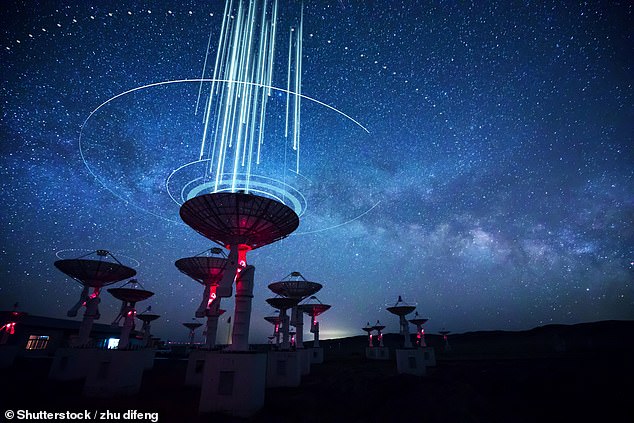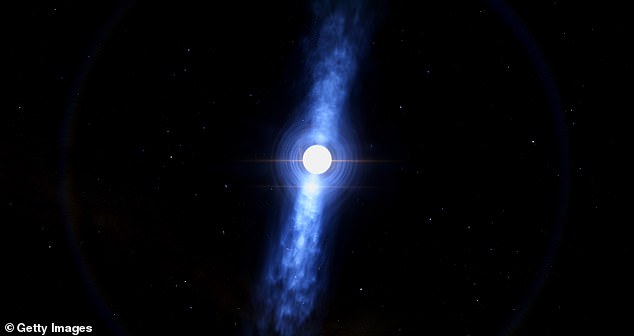Source of ‘alien’ radio signals may have been discovered by scientists studying the pulses that travel at the speed of light
>
- Thousands of radio signals have been detected, but the sources have not been confirmed
- Scientists now believe that they are similar to earthquakes that occur on Earth
- Read more: Astronomers discover five new fast radio bursts
Scientists have been detecting mysterious radio signals traveling through space for more than a decade, and they are mystified as to what could produce such wild pulses.
Some experts believe that fast radio bursts (FRBs) could be aliens trying to contact Earth, while others suspect black holes as the source.
Now, researchers at the University of Tokyo have proposed that fast radio bursts are caused by stellar quakes on rapidly rotating neutron stars, which have the strongest magnetic fields in the known universe.
The team found that the energy released by tremors on the surface of neutron stars is similar to that on Earth.

Scientists at the University of Tokyo believe that the “strange” radio signals are actually “starquakes” emanating from rapidly rotating neutron stars that possess the strongest magnetic fields in the known universe.
The first FRB was observed, or rather “heard” by radio telescopes, in 2001 but was not discovered until 2007 when scientists were analyzing archival data.
Professor Tomonori Totani said: “Recent observational advances have led to the discovery of thousands more fast radio bursts, so we took the opportunity to compare the large statistical datasets now available for fast radio bursts with data from earthquakes and solar flares, to explore potential similarities.”
For the study, the team calculated correlation across 2D space, allowing them to analyze the time and emission energy of nearly 7,000 bursts from three different fast radio burst sources.
They then used the same technique to examine the relationship between earthquakes, time and energy, using data from Japan, and solar flares, and compared the results of all three phenomena.

The team found that the energy released by tremors on the surface of neutron stars (artistic impression) is similar to that found on Earth.
The final analysis showed a “striking” similarity between fast radio bursts and seismic data – four to be precise.
Both experienced an aftershock 10 to 50 percent of the time after each event, and the incidence of aftershocks decreases over time, as a temporal force.
A third similarity is that the rate of aftershocks is always constant even if the FRB seismic activity changes significantly.
“Fourthly, there is no relationship between the energies of the main shock and its aftershocks,” Totani said.
“This strongly suggests that there is a rigid crust on the surface of neutron stars, and that starquakes that occur suddenly on these crusts release huge amounts of energy that we see as FRBs.”
The team plans to continue analyzing new data on fast radio bursts, to verify that the similarities they have found are universal.
Professor Totani added: “By studying stellar quakes on distant, ultra-dense stars, which are very different environments from Earth, we may gain new insights into earthquakes.
“The interior of a neutron star is the densest place in the universe, compared to the interior of an atomic nucleus.
“Stellarquakes in neutron stars have opened the possibility of gaining new insights into high-density matter and the fundamental laws of nuclear physics.”
It is estimated that up to 10,000 FRBs could occur every day if we could observe the entire sky.
While most burst sources discovered so far appear to emit a one-time event, about 50 fast burst sources emit bursts repeatedly.
(Tags for translation)dailymail
